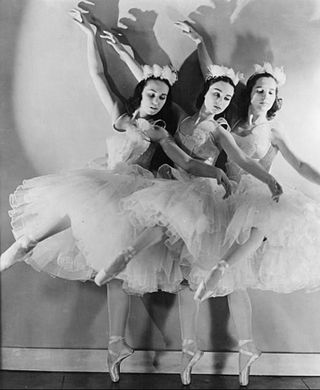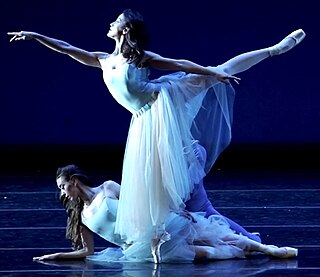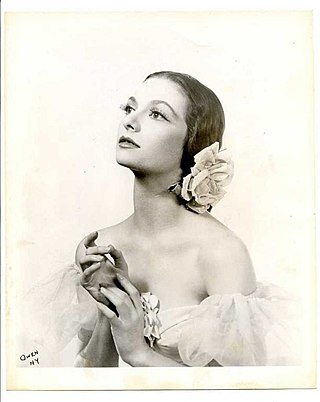
George Balanchine was an American ballet choreographer of Russian-Georgian origin, recognized as one of the most influential choreographers of the 20th-century. Styled as the father of American ballet, he co-founded the New York City Ballet and remained its artistic director for more than 35 years. His choreography is characterized by plotless ballets with minimal costume and décor, performed to classical and neoclassical music.

New York City Ballet (NYCB) is a ballet company founded in 1948 by choreographer George Balanchine and Lincoln Kirstein. Balanchine and Jerome Robbins are considered the founding choreographers of the company. Léon Barzin was the company's first music director. City Ballet grew out of earlier troupes: the Producing Company of the School of American Ballet, 1934; the American Ballet, 1935, and Ballet Caravan, 1936, which merged into American Ballet Caravan, 1941; and directly from the Ballet Society, 1946.

Lincoln Edward Kirstein was an American writer, impresario, art connoisseur, philanthropist, and cultural figure in New York City, noted especially as co-founder of the New York City Ballet. He developed and sustained the company with his organizing ability and fundraising for more than four decades, serving as the company's general director from 1946 to 1989. According to the New York Times, he was "an expert in many fields", organizing art exhibits and lecture tours in the same years.

San Francisco Ballet is the oldest ballet company in the United States, founded in 1933 as the San Francisco Opera Ballet under the leadership of ballet master Adolph Bolm. The company is currently based in the War Memorial Opera House, San Francisco, and effective December 2022 under the direction of Tamara Rojo. It is among the world's leading dance companies, presenting more than 100 performances annually, with a repertoire that spans both classical and contemporary ballet. Along with American Ballet Theatre and the New York City Ballet, San Francisco Ballet has been described as part of the "triumvirate of great classical companies defining the American style on the world stage today."

The company Ballets Russes de Monte-Carlo was formed in 1932 after the death of Sergei Diaghilev and the demise of Ballets Russes. Its director was Wassily de Basil, and its artistic director was René Blum. They fell out in 1936 and the company split. The part which de Basil retained went through two name changes before becoming the Original Ballet Russe. Blum founded Les Ballets de Monte Carlo, which changed its name to Ballet Russe de Monte Carlo when Léonide Massine became artistic director in 1938. It operated under this name until it disbanded some 20 years later.

Stars and Stripes is a neoclassical ballet choreographed by George Balanchine to music by John Philip Sousa, orchestrated by Hershy Kay. The ballet was made as a tribute to the United States, Balanchine's adopted country. It premiered on January 17, 1958, at the City Center of Music and Drama, danced by the New York City Ballet. It is dedicated to Fiorello La Guardia, former mayor of New York City. The ballet had been revived by multiple ballet companies, and at different special occasions.
Ballet Society is a non-profit educational institution founded in 1946 by Lincoln Kirstein and George Balanchine. At its founding, Balanchine was the Artistic Director and Kirstein served as the Secretary. The president of Ballet Society is Nancy Lassalle, an original Board member of both the School of American Ballet and the New York City Ballet, currently Emerita.

Serenade is a ballet by George Balanchine to Tchaikovsky's 1880 Serenade for Strings in C, Op. 48. Serenade is credited as being George Balanchine's first full-length ballet in America. Using the students of his newly formed School of American Ballet, Balanchine choreographed this ballet for an American audience that had not been widely exposed to ballet before. Students of the School of American Ballet gave the first performance on Sunday, 10 June 1934 on the Felix M. Warburg estate in White Plains, N.Y., where Mozartiana had been danced the previous day. It was then presented by the Producing Company of the School of American Ballet on 6 December at the Avery Memorial Theatre of the Wadsworth Atheneum with sets by the painter William Littlefield. Balanchine presented the ballet as his response to the generous sponsorships he received during his immigration to America. The official premiere took place on 1 March 1935 with the American Ballet at the Adelphi Theatre, New York, conducted by Sandor Harmati.
Orpheus is a thirty-minute neoclassical ballet in three tableaux composed by Igor Stravinsky in collaboration with choreographer George Balanchine in Hollywood, California in 1947. The work was commissioned by the Ballet Society, which Balanchine founded together with Lincoln Kirstein and of which he was Artistic Director. Sets and costumes were created by Isamu Noguchi.
Lewellyn Farr Christensen was a ballet dancer, choreographer and director for many companies. He was largely associated with George Balanchine and the San Francisco Ballet, which he directed from 1952–1984. Other companies Christensen was a part of include Ballet Caravan, directed by Lincoln Kirstein, and Ballet Society, directed by Kirstein and Balanchine.
Tschaikovsky Piano Concerto No. 2, also titled Ballet Imperial, is a ballet choreographed by George Balanchine to Tchaikovsky's Piano Concerto No. 2. Ballet Imperial was choreographed for American Ballet Caravan's 1941 South American tour, and was aimed at showing that the Americans were capable of the classical ballet traditions. The ballet pays tribute to Tchaikovsky, the classical ballet choreographer Marius Petipa, and Imperial Saint Petersburg, where Balanchine received his ballet training. The ballet featured academic steps and alludes to Imperial Russia through the costumes and scenery. Ballet Imperial premiered on June 25, 1941, at Teatro Municipal, Rio de Janeiro.
Chaconne is a ballet made by New York City Ballet co-founder and ballet master George Balanchine to ballet music from Gluck's Orfeo ed Euridice. The premiere took place Wednesday, 22 January 1976 at the New York State Theater, Lincoln Center, with lighting by Ronald Bates; Robert Irving conducted. Chaconne was danced in practice clothes at its premiere; Karinska's costumes were added in the spring season.

Concerto Barocco is a neoclassical ballet choreographed by George Balanchine to Bach's Concerto for Two Violins. Danced by a cast of eleven, the ballet is completely plotless, and according to Balanchine, "has no "subject matter" beyond the score which it is danced and the particular dancers who execute it". The ballet was made for the American Ballet Caravan's 1941 South American tour, and premiered on June 27, 1941, at Teatro Municipal, Rio de Janeiro. The ballet has entered the repertories of many ballet companies, including Balanchine's New York City Ballet.
Ronald Bates was an American ballet lighting designer, particularly for the New York City Ballet.
Heidi Vosseler (1918–1992) was an American ballerina who trained under Catherine Littlefield in her hometown of Philadelphia before becoming a member of George Balanchine's first American ballet company, American Ballet in 1934. She performed in his first American ballet, Serenade, in his Alma Mater, in two productions he choreographed for the Metropolitan Opera, and was featured in two Broadway musicals he choreographed, The Boys from Syracuse and Louisiana Purchase in which she understudied and appeared for Vera Zorina. Her sister Mardee was also a ballerina.

Olga Elise Reiman was an American ballet dancer and dance educator. After starting her career working with choreographer Adolph Bolm, she danced at the American Ballet and Ballet Society, both forerunners of the New York City Ballet, and originated several roles for choreographer George Balanchine. Reiman taught at Balanchine's School of American Ballet between 1945 and 1953 and from 1964 until her death.
Balanchine technique or Balanchine method is the ballet performance style invented by dancer, choreographer, and teacher George Balanchine (1904–1983), and a trademark of the George Balanchine Foundation. It is used widely today in many of Balanchine's choreographic works. It is employed by ballet companies and taught in schools throughout North America, including the New York City Ballet and School of American Ballet, where it first emerged.

Ruthanna Boris was the first American Ballerina to star with the Ballet Russe de Monte Carlo troupes of the 1940s. She was born in Brooklyn. She was among the first students at George Balanchine and Lincoln Kirstein’s School of American Ballet when it opened in 1934. As a choreographer her ballets Cirque de Deux and Cakewalk, are often revived. She died in El Cerrito, California and her papers are held at Houghton Library, Harvard University.

Mary Ellen Moylan was an American ballet dancer. She was one of the first students of George Balanchine's School of American Ballet, and made her New York stage debut in 1942. She had danced with Ballet Russe de Monte Carlo, Ballet Society, Ballet Theatre, Metropolitan Opera Ballet, and on Broadway. She was best known for performing Balanchine's works, and was described as "the first great Balanchine dancer". She retired from performing in 1957.
La Valse is a ballet choreographed by George Balanchine to Maurice Ravel's Valses Nobles et Sentimentales and La Valse. It premiered on February 20, 1951, at the City Center of Music and Drama, performed by the New York City Ballet. The ballet depicts dancers waltzing in a ballroom, during which a woman becomes attracted to a figure of death, and ultimately dies.